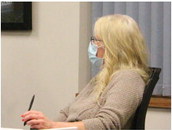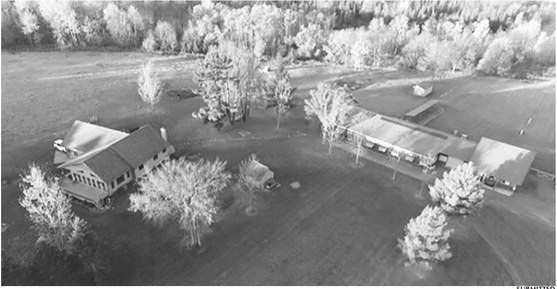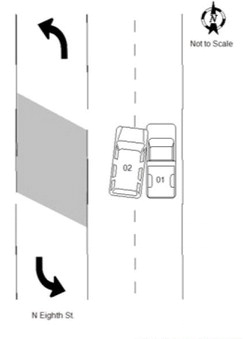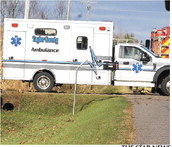Back to voters


Voters to get second try at $39.9 million high school referendum
Voters in the Medford school district will get a second chance to weigh in on a proposed $39.9 million package of high school renovations.
After nearly an hour of discussion, school board members voted unanimously Monday night to send the same referendum back to voters for the April 6 spring election. The referendum had failed by 174 vote margin in the highturnout election that saw more than 6,900 votes cast.
Over the past month, school board members and administrators have made several hundred phone calls to area residents asking for input on the referendum project and why people either opposed it or supported it. They also asked residents if the district should try again.
“Of the 36 people I talked to 11 said they didn’t support it, 17 said they supported it, four weren’t aware it and four didn’t want to talk,” said district administrator Pat Sullivan reporting to the board on the calls he made. The call list was divided between administrators in each of the buildings and board members from the poll list. At last month’s board meeting, member John Zuleger had suggested seeking input from voters on a personal level as a way to “make them part of the conversation.” The idea was firmly endorsed by board president Dave Fleegel.
At Monday’s board meeting, Sullivan noted that he had initially been resistant to making the calls, but after doing so felt the input was very valuable. He said of the people he spoke to concerns over the economic impact of COVID-19, not wanting their taxes to go up, the belief that the building should last more than 50 years and that there was too much emphasis on sports were issues cited by residents opposed to the project. Of those supporting, he said the need for space and the need to make an investment in the future were the top comments.
Sullivan’s feedback was echoed by high school principal Jill Lybert, middle school assistant principal Justin Hraby, elementary principals Dan Miller and SuAnn Schroeder and student services director Joe Greget.
“People were very positive and encouraging us to go forward,” Lybert said.
Hraby said it was about 60% to 40% with 60% of the people he talked with saying to go back to voters with the same dollar amount and the same project.
Miller reported in a conversation with an 84-year-old in the community who had seven children go through the district and who supported the project noting it was important to make an investment in the future.
He said some of the negatives he heard were people questioning if everything was truly needed and the suggestion to take a fine-toothed comb to the project and bring it back to voters.
Sullivan said there was a perception among some people that traditional brick and mortar schools would somehow become obsolete due to changes in technology and virtual learning. “To us that is a crazy idea,” he said, noting the comment he hears most is from parents saying they can’t wait to get their kids back in school.
School board member Oralee Dittrich said she received concerns about extra gym space, but that about 70% of the people she talked with were in favor of the project. DeDe Strama said the majority of people she talked to felt they were not adequately informed about the project saying that because they did not have students in the district they had not looked in the district newsletter. “They got inundated with political ads and everything went into the trash,” she said.
Zuleger said concerns he heard included people not being clear about what was happening with the space of the current Red/White Theater. He also had a resident comment that the district had looked at the dollar amount and cut the project to reach that amount rather than sending it to voters with what they needed. He also noted that there were those who simply did not want their taxes to go up. “I think there is a certain group who will never want their taxes to go up,” he said.
Fleegel said he had a mixed group but came away with the need for people to make investment in the future of the district. He told of one family in the district that after the election had the father proposing moving to a district that recognized the need for education. Board member Paul Dixon said the feedback he got was that people did not feel well-informed about the project.
Board member Cheryl Wibben said that among those she spoke to in the town of Holway there were individuals going door to door prior to the election telling people to vote against it. She also was told that while the board had visited all the town board meetings, they would get to the residents more by stopping at the dumpsites as people bring in garbage and recycling.
Board member Barb Knight said of her calls, there were the same sorts of comments about people wanting more information. She also emphasized the need to make an investment in the district’s future.
Board member Steve Deml said some of the feedback he received was that people voted against the project not so much based on the merits of the project, but for other reasons such as things they disagreed with the district in the past or how money was spent previously. “It wasn’t about the referendum, it was about past things that had happened,” he said. He said it was important that board members and staff realize that the things they do or say to people can positively or negatively impact the district for a long time.
He also said that any diagrams of the building should also include the parking areas because people were unclear where parking would be. The plan calls for moving a significant amount of parking to the front of the building in area that is currently lawn.
Sullivan said the phone calls were valuable and suggested the district continue to do them going forward. “We had some quality conversations,” he said. Strama also suggested the need for a community campaign to support the project. Fleegel stopped her proceeding noting that under state law, all the district can do is provide information about the referendum and while they would assist any “vote yes” group with information they would equally assist any “vote no” groups if they asked for information.
One of the challenges in the district’s previous plan to get the word out was that COVID-19 restrictions on organization meetings and gatherings over the fall made it hard to get to people. As far as timing for the election, state law changes in recent years have limited districts when it comes to going to voters. Referendums can only be held during regular elections such as during the spring or fall and districts can only ask two referendum questions per year. Because there is no fall election in odd-numbered years the only chance to go to voters in 2021 is at the April election. If the district held off on bringing it forward, it would have to wait until April 2022.
Given the narrow margin and the opportunity to better inform residents of the need of the project, board members voted to send the $39.9 million referendum project back to voters.
In other business, board members:
_ Reviewed the changes in the quarantine rules. The district has adopted new quarantine guidelines that allow for a swifter return to school. However Sullivan said teachers and students with doctors notes waiving them from mask requirements for medical reasons would be required to wear masks if they came back under the shortened quarantine period.
_ Received a demonstration and report on 3-D printing and the engineering classes using this as a tool to help them create prototypes for projects in the program. Project Lead The Way teacher Tracy Swedlund reported that the 3-D printer he brought for demonstration to the school board has more than 143 days and 10 hours of run time since it was purchased by the district using a combined 3.2 miles of filament.
_ Approved eliminating the requirement to track points for the district employees’ wellness program. Staff must still do the biometric screening, get a physical and do a health assessment in order to qualify for an insurance discount, but will not have to keep track of specific points. Sullivan proposed the change as a way to reduce stress of employees.







